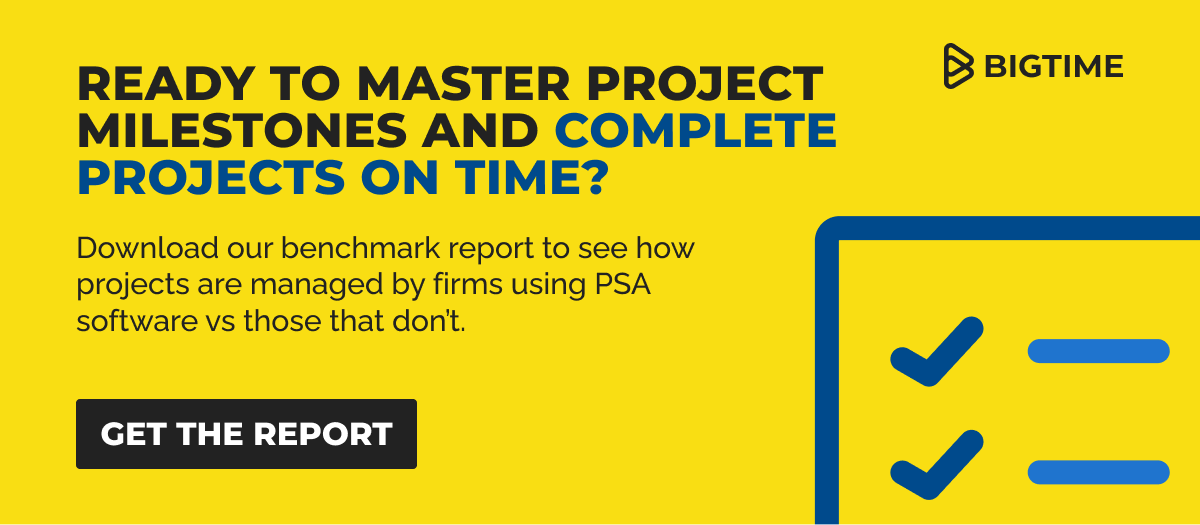
Last updated March 28th, 2023
We’re probably most familiar with hearing about milestones from new parents – baby’s first steps, words, and birthday. While some parents are great with tracking these moments, anyone who’s the youngest kid in the family knows this trails off.
The same problem can happen with project and task managers. You become too busy with your tasks at hand that best practices are often overlooked. Understanding key project management milestones and establishing project dependencies will help you crawl, walk, run–which is crucial for ensuring the efficiency and success of a project from the start.
Before we look at how project management milestones, tasks, and dependencies come together to create the perfect recipe for project management success, we’ll break down tips for effectively mapping dependencies and milestones to your project so it adds to your plan’s value rather than become stressful clutter in your project roadmap.
What Are Dependencies in Project Management?
Dependencies are simply tasks (items on your to-do list) that have a dependent relationship with another task. One cannot be done before the other is completed, so they must be carefully managed to avoid delays or other issues.
Project Dependencies Examples
One example of a project management dependency is you can’t edit a video before you record it. This would be considered a logical dependency, which can’t be avoided due to the nature of the project or task at hand. Without the completion of the first task, the second task doesn’t make sense in any way.
Although logical dependency is the most commonly thought of dependency, there are two other types of project management dependencies that should be considered when thoughtfully planning out your project.
Resource-based dependencies are a constraint within the project due to a lack of resources available. This could include a staff member being out of the office, a hold in approvals, or a lack of materials needed to complete the task. Logical and resource-based dependencies aren’t typically seen together, normally the tasks hindered by resource-based dependencies could be completed together if the resources were available.
Preferential dependencies are driven by the preferred work order or best practices. These are set up initially at the start of the project to give the executors the optimal chance for success. Some leniency is often built into preferential project plan dependencies to account for unforeseen roadblocks or errors.
After key dependencies are set, take a look back through them and see if any of them sound like risks to your project. Make note of the flagged risks or challenges that your dependencies brought up. While dependencies are a perfectly natural flow for most projects, some may shed light on areas you want to give your team more time or pull in additional resources to improve the process.
Project management dependencies are also good indicators for communication, which is essential to any project success. Setting dependencies gives team members a clear understanding of when someone else is waiting on their tasks to be completed or is in need of approval to move forward, and gives them a cue to communicate their status.

What is a Milestone in Project Management?
Milestones in project management are markers or signs of a goal being completed. Sometimes misplaced for a task, milestones should be reserved for things that show significant progress or ensure a project is on schedule. Tasks are deliverables that lead up to the project milestones. As stated by PMI, “[Milestones] refer to a point in time, not a period of time. Second, it looks forward to what we want to create, not how we create it.”
Effective project plan milestones have specific significance and are attainable, timely, and progressive.
Adding milestones into your project ensures that your plans are not just task-oriented but results-oriented. Milestones are also the best way to communicate progress to outside stakeholders. Instead of letting them know a list of tasks that you checked off you can communicate the goal that was reached at the end of each project phase.
Project Milestone Examples
To start, approval milestones mark a completed phase of a project that requires the input of an outside member. Approval milestones are significant when it’s vital that this phase of the project receives a stamp of approval before moving forward. Mapping milestones with generous time allowed is also important because they often can cause bottlenecks in the project.
Deadline milestones are set as your matter-of-fact deadlines. Other task deadlines throughout the project may have some leniency to account for unexpected delays, but milestones should be seen as a harder project management deadline to ensure your project is still moving forward at the right pace.
Meeting milestones signify the team coming together to review their completed tasks and move on to the next phase of the project. These milestones should be reserved for meetings that are tracking the progress of the overall project rather than discussing or collaborating on how to complete a task.
There isn’t a magic number of milestones for all projects, but remember that they should never outweigh the number of tasks a project has. If this is happening you may be mistaking some milestones for tasks. A good way to check if your milestones are effective is to think of what your boss’ boss would want to hear as a project update.
Once your goals, task list, dependencies, and milestones are set in that order you’ve got the perfect recipe for a successful project.
How to Identify Project Management Milestones and Dependencies
The first step in mapping dependencies and milestones is to break down the project into smaller, sub-tasks. After you have a full list, you can start making note of which ones are critical to the success of the project and which ones can be completed independently.
The critical tasks will become your project milestones. Dependencies can then be identified by looking at which tasks must be completed before another one can begin. It’s important to distinguish milestones and dependencies at the start and then clearly communicate them to the project team so everyone is on the same page.
Be prepared to review your list throughout the course of the project and update it as needed if things change or unexpected issues arise.
Project Timeline Management: Tools for Tracking Project Milestones and Dependencies
There are many tools and techniques available for tracking and communicating project management milestones and dependencies. One popular tool is a Gantt chart, which provides a visual representation of your project tasks, dependencies and milestones altogether. After gathering your lists, Gantt charts allow you to set up your project in a bar timeline to get a clear, big-picture view of the project roadmap and the amount of time that will be needed to complete the project.
Another useful tool is project management software, which can be used to track tasks, assign responsibilities, and set deadlines. Using professional services automation (PSA) and project management software for consultants together can provide your company with the resources and reporting needed to get projects and payments completed on time.
Summary
Project management milestones and dependencies can help project managers by allowing them to strategize, plan and execute tasks more efficiently. With a streamlined approach in place that’s enhanced by the right tools and techniques, services organizations can better prepare for project contingencies and reduce risk in the project life cycle.
To see how project managers are using BigTime’s Gantt chart tool, request a demo of our PSA software. Or, visit our blog to learn more about PSA vs. PM software.

Frequently Asked Questions About Project Management Milestones and Dependencies
What is a project milestone?
A project milestone is a marker that signifies the completion of a goal. Though sometimes confused with tasks, milestones should be specifically used for achievements that demonstrate significant progress or that indicate the project is on schedule.
What are types of dependencies in project management?
Three types of dependencies in project management include:
- Logical dependency – A task that can’t be avoided due to the nature of the project or task at hand. Without the completion of the first task, the second task doesn’t make sense in any way.
- Resource-based dependencies – This type is a constraint within the project due to a lack of resources available. This could include a staff member being out of the office, a hold in approvals, or a lack of materials needed to complete the task.
- Preferential dependencies – A dependency driven by the preferred work order or best practices.
What are project milestones examples?
Project milestones examples include:
- Approval milestones – An achievement that marks a completed phase of a project that requires the input of an outside member.
- Deadline milestones – Tasks that are set as matter-of-fact deadlines.
- Meeting milestones – These signify the team coming together to review their completed tasks and move on to the next phase of the project.





